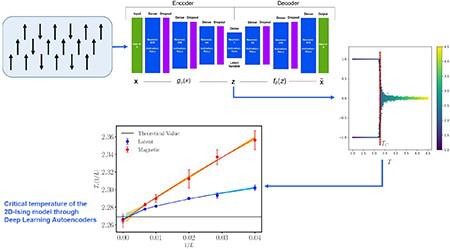The European Physical Journal B ( IF 1.6 ) Pub Date : 2020-12-07 , DOI: 10.1140/epjb/e2020-100506-5 Constantia Alexandrou , Andreas Athenodorou , Charalambos Chrysostomou , Srijit Paul

|
Abstract
We investigate deep learning autoencoders for the unsupervised recognition of phase transitions in physical systems formulated on a lattice. We focus our investigation on the 2-dimensional ferromagnetic Ising model and then test the application of the autoencoder on the anti-ferromagnetic Ising model. We use spin configurations produced for the 2-dimensional ferromagnetic and anti-ferromagnetic Ising model in zero external magnetic field. For the ferromagnetic Ising model, we study numerically the relation between one latent variable extracted from the autoencoder to the critical temperature Tc. The proposed autoencoder reveals the two phases, one for which the spins are ordered and the other for which spins are disordered, reflecting the restoration of the ℤ2 symmetry as the temperature increases. We provide a finite volume analysis for a sequence of increasing lattice sizes. For the largest volume studied, the transition between the two phases occurs very close to the theoretically extracted critical temperature. We define as a quasi-order parameter the absolute average latent variable z̃, which enables us to predict the critical temperature. One can define a latent susceptibility and use it to quantify the value of the critical temperature Tc(L) at different lattice sizes and that these values suffer from only small finite scaling effects. We demonstrate that Tc(L) extrapolates to the known theoretical value as L →∞ suggesting that the autoencoder can also be used to extract the critical temperature of the phase transition to an adequate precision. Subsequently, we test the application of the autoencoder on the anti-ferromagnetic Ising model, demonstrating that the proposed network can detect the phase transition successfully in a similar way.
Graphical abstract
中文翻译:

通过深度学习自动编码器的2D阻尼模型的临界温度
摘要
我们研究了深度学习自动编码器,用于无监督地识别晶格上形成的物理系统中的相变。我们将研究重点放在二维铁磁伊辛模型上,然后测试自动编码器在反铁磁伊辛模型上的应用。我们使用在零外部磁场中为二维铁磁和反铁磁伊辛模型产生的自旋配置。对于铁磁伊辛模型,我们对从自动编码器提取的一个潜变量与临界温度T c之间的关系进行了数值研究。拟议的自动编码器揭示了两个阶段,一个阶段的自旋排序,另一个阶段的自旋无序,反映了,2的恢复。温度升高时对称。我们为晶格尺寸不断增加的序列提供了有限体积分析。对于研究的最大体积,两相之间的转变非常接近理论上提取的临界温度。我们定义为一个准序参量的绝对平均潜在变量z ,这使我们能够预测的临界温度。可以定义一个潜在磁化率,并用它来量化不同晶格尺寸下的临界温度T c(L)的值,并且这些值仅受很小的有限缩放作用。我们证明T c(L)外推到已知的理论值L→ ∞表示自动编码器也可以用于提取相变的临界温度到足够的精度。随后,我们测试了自动编码器在反铁磁Ising模型上的应用,证明了所提出的网络可以类似的方式成功检测到相变。











































 京公网安备 11010802027423号
京公网安备 11010802027423号